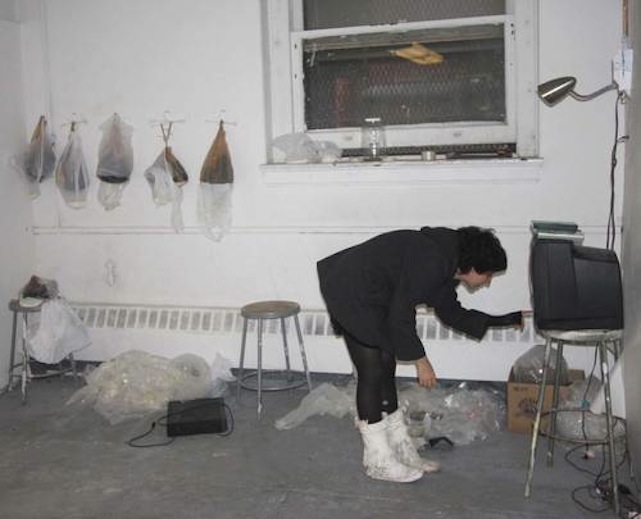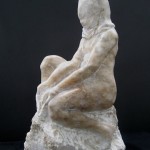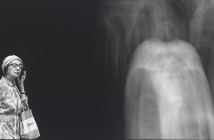Torture is still in the air. Only two months ago, United States Attorney General Eric Holder confirmed that no further action would be taken to prosecute anyone for the deaths of two men held by the CIA, one in Iraq in 2003, and the other in Afghanistan in 2002. These were the last of one hundred cases of alleged mistreatment that were investigated, but not one of which resulted in either indictment or trial. A few days after that announcement, Human Rights Watch published a report documenting previously unacknowledged uses of waterboarding on Libyans detained by the CIA. They were later transferred into the custody of the Gadhafi government, where they were subjected to further torture.
Murmurs regarding legality and impunity still complicate the efforts being made by our society to come to terms not only with its crimes, but also with its indifference. We might have been better prepared four years ago, had we better understood then the lessons of an apparently unrelated incident of public dismay over a work of art.
In April of 2008, Aliza Shvarts, in fulfillment of the requirements for an arts major at Yale University, announced the submission of a senior project that would include videos of what she described as a series of self-induced miscarriages, along with a display of blood that resulted from them. "They say, blood will have blood." and it will. Although when Shakespeare claimed so in Macbeth, he could hardly have had in mind this proposed art installation by an undergraduate or the vituperative responses to it.
This could not help but evoke Linda Nochlin’s 1971 declaration that woman artists needed to confront those who were responsible for dismissing them: "The fault lies not in our stars, our hormones, our menstrual cycles, or our empty internal spaces, but in our institutions, and our education." It also recalled the bloodletting in the staged works—from that same decade—carried out by Gina Pane who asserted "Our entire culture is based on the representation of the body. Performance does not so much annul painting as help out the birth of a new painting based on different explanations and functions of the body in art." Given these earlier insights, it could have been argued that Shvarts was simply being clear that her body was not to be reduced to a mere reproductive mechanism.
Instead, there was an almost obligatory frenzy to the catalogue of outrage that emerged when the first details of the work were made public in a Yale Daily News report. The President of the National Right to Life Committee described it as the "clearly depraved" act of "a serial killer." A spokesman for NARAL Pro-Choice America called it "offensive and insensitive to the women who have suffered the heartbreak of miscarriage."
And the authorities at Yale were a match for the outside critics, although their vocabulary was somewhat less inflammatory, beginning with the Dean of Yale College, who was "appalled," he said, at this work of "performance art" that "bears no relation to what I consider appropriate for an undergraduate senior project." "If I had known about this," asserted the Dean of the Yale School of Art in exculpatory precision, "I would not have permitted it to go forward."
In response, Shvarts disingenuously explained "it’s not the intention of the piece to scandalize anyone," at the same time as she produced an oxymoron by predicting that "some people will be upset with the message and will not agree with it."
Assuming she intended to create a message, then the question immediately arises as to what it was. What did it say about a woman’s control over her body or the right to abortion? Shvarts used the term "induced miscarriage" to describe the process, which is an euphemism indeed. If naming is indeed an "ideological act," as she herself claimed, than this omission of vocabulary was revealing in its timidity.
Was it real or fakery? For Shvarts, what was the most "poignant" and politically meaningful element in her work was "the impossibility of accurately identifying the resulting blood"—a point she claimed all other commentary had overlooked.
This was not "ambivalence"—the word Shvarts used—as in an uncertainty about how to respond, but rather, "ambiguity"—a lack of clarity about what was being responded to. Even those few who were publicly supportive of the work found confusion unavoidable, as in the case of the writer Warren Ellis who was impressed by Shvarts "if she’s doing what I think she’s doing." The hoax was to be celebrated. But what if there was no deception?
It was this very lack of clarity that gave her critics license to read the work in ways that assumed their worst possible cases. One Yale administrator authoritatively declared—after a meeting with Shvarts meant to counter the growing hysteria of the media—that "the entire project is an art piece, a creative fiction designed to draw attention to the ambiguity surrounding [the]form and function of a woman’s body." When Shvarts immediately went public with a statement denying this conclusion, the same administrator declared that "her denial is part of her performance," and, on a melancholy note, confessed to being "disappointed that she would deliberately lie to the press in the name of art."
This exchange in itself had a theater of the absurd quality that almost stood alone as an artistic achievement. But if I were to guess, it would be to say that Shvarts had done nothing to anticipate the form or the extent of what her undertaking would provoke. As a result she had only spontaneous jargon to offer in her defense. When that unsurprisingly compounded the outcry, she lapsed into silence. Though I did invite her to comment by e-mail, I did not anticipate a reply and none was forthcoming. But there was really no mystery to be solved about the nature of the work. "The piece exists only in its telling" was one of her statements that was clear enough. It left one to wonder if the art was ever meant to exist physically at all.
But it is the history of the response to the work, and not only the work itself or the artist’s motives that raises the most crucial questions about the social function of art in contemporary American society. If Shvarts, as she claimed, created "a project that lives up to the standard of what art is supposed to be," then where was that standard to be found? For her to claim "the performance exists only as I chose to represent it," is an artist’s mediocre fantasy that would apply only to work that is politically unimportant.
Given that Shvarts confessed to a strong belief that "art should be a medium for politics and ideologies, not just a commodity," there could be a case made for the use of ambiguity as a consciousness-raising instrument. Here was an unequivocal statement of what she saw as her responsibility. It was not a matter of some conditional freedom, which an artist may exercise only—according to a member of the Yale faculty—if that artist takes "full intellectual accountability for the strong response he or she may provoke." But accountability in this case does not lie all on one side. The audience of commentators also bears responsibility for willfully—through malevolence or self-interest—distorting an artist’s work.
And so a professor of art at Williams College, writing in the Wall Street Journal, declares that Shvarts is "inadvertently" raising the question of "how exactly is Yale teaching its undergraduates to make art?" A columnist in Newsweek predicts that the incident will be used " as proof that all an aspiring artist need do for celebrity is create a piece offensive enough to be banned by an institution," thereby concluding that—for all her political claims, Shvarts’ real concern was the market. For the president of the American Council of Trustees and Alumni, the central problem that results from this controversy has only to do with Yale’s addressing "the institutional framework that approved and supported this project."
This last at least raises the possibility of failures—not only by the university—but in the artist’s relationship to it. Outside of some hollow statements of concern for her physical and mental health, Yale never acted other than in defense of its own institutional reputation. Shvarts did declare that all she wanted was "to get back to a point where they (representatives of the unversity) renew their support, because ultimately this was something they supported." What evidence there was for this was never offered, but her abandonment by the institution appears to have mattered to her. Whether this was naive or manipulative, it is uninteresting from the point of view of the art itself. If the piece was meant as a political challenge, it is difficult to see how Yale’s self-righteous posturing could have been a surprise.
The MFA program at that university has acquired an almost transcendent status as a guarantee of artistic currency in the brutal merchandising that the culture now requires. But it has never been known as a place in which social activism was considered any more than an aberrant phase that an artist might pass through on the way to the abstractions that matter.
In the end she had no subject. The media exposure exhausted the power of the work over issues that were unimportant. The horror was displaced by the acceptable, fictional distresses of her audience, while the actual terrors which demand confrontation in our country—but which its citizenry, including its artists, are largely evading—abide. Did Shvarts hope for a revolution in the institutional vision of the University as a result of her work? If so, the object of her hope is where the political problem lies. She was clearly unprepared to confront the cultural hypocrisy of the responses to her work. If she had been more astute, several events contemporary to her censure would have provided material for a useful retort.
Also in early April of 2008, public announcements were made of unambiguous horrors that failed to produce responses that could even begin to compare, in either number or intensity, with the imaginary constructs fashioned by those who condemned Shvarts’ work. An ABC News report detailed meetings of White House officials where the minutiae of "enhanced interrogation techniques" were outlined and scheduled for specific persons in CIA custody, including "whether they would be slapped, pushed, deprived of sleep or subjected to simulated drowning, called waterboarding." One of the participants was thoughtful enough to comment that "History will not judge this kindly."
But the crucial question is the judgment of the present. With a Yale alumnus who was president at the time overseeing the institutionalization of torture with the use of Justice Department memoranda which one Washington Post columnist described as formalizing the belief that "that anything the president or his designates do—no matter how illegal, barbaric or un-American—is justifiable in the name of national self-defense," the university—and the press—have developed a tolerance that was not made available to the fictions of Aliza Shvarts. And their silence is shared by a member of the Senate who yet found time to decry video games that are "becoming more and more vivid, violent, and offensive to our most basic values ...and beyond all decency." Think here of the mother in The Catcher in the Rye who tears up at a movie scene, then smacks her child who is desperate to use the toilet.
There are artists who have confronted the consequences of the above-noted legal fiction, which has been described as " . . . in effect, the blueprint that led to Abu Ghraib." But works such as Fernando Botero’s paintings of the men brutalized in that prison and the exquisite ironic marbles of hooded men carved by the Iraqi artist Abdel-Karim Khalil are considered eccentric anomalies, if they are considered at all
The artist Pia Lindman, who as a lecturer at Yale served as Aliza Shvarts’ adviser, made no public statement on the matter of the suppressed project, although there was a report that "appropriate action" had been taken by Yale against members of the faculty who had approved what Shvarts had undertaken. But in earlier comments made regarding the effects of 9/11 upon American culture, Lindman proclaimed herself "still waiting for this self-aggrandizing mass psychosis—the uncritical belief in the omnipotence and goodness of the American people, troops and government—to dissolve and have it replaced with sober self-reflection." Sobriety was clearly not a function of the discussion around Shvarts’ work
But sobriety may no longer be useful as a strategy for moral criticism. We are long past the time when the simple thought of Medea’s children slaughtered behind closed doors is a sufficient call to dismay over the human capacity for self-destructive evil. And—as in the arts—the power of the imagination has lost its hold over the employees of power who once relied on merely showing the instruments of torture to produce their desired results.
Aliza Shvarts could have found a subject that made us see clearly what frightens us most—our own faces in those of the torturers. That could yet happen, through hers or someone else's new work, and art would be made of a horror that belongs to us alone. But what Shvarts did accomplish, however unintentionally, is almost equally important. The controversy over her work exposed a central irony in American culture: that a tragedy of manners in which the disguise of tastefulness is threatened is far more unnerving to us than the moral tragedies of state-licensed torture and murder. The lie that our personal security is dependent upon the commission of such crimes provides a useful evasion for our consciences. We pretend to be shocked only by what does not matter. This was once known as the road to perdition.
- Abu Ghraib
- Richard Serra, Stop Bush, Lythocrayon on Mylar, 2004. Collection of the artist, copyright 2006 Richard Serra/Artists Rights Society (ARS)
- Abdel-Karim Khalil, untitled, Marble, 2004.
- Aliza Shvarts in her studio, from Yale Daily News







